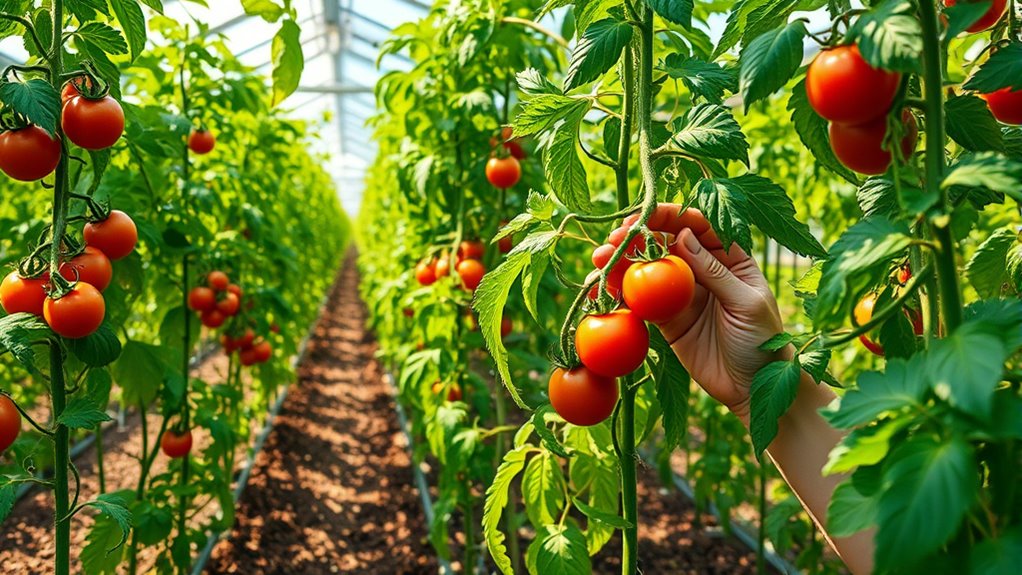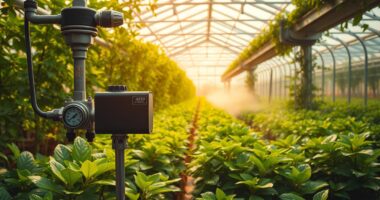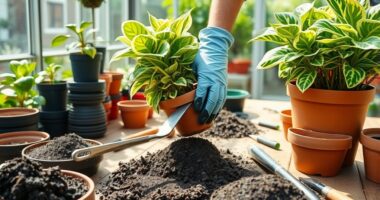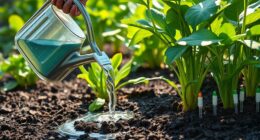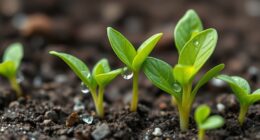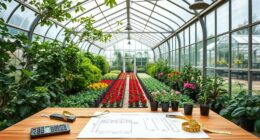To successfully grow tomatoes in your greenhouse, choose the right varieties, like indeterminate for continuous harvests or compact determinate types for small spaces. Set your greenhouse temperatures ideally between 70°F and 80°F and guarantee good ventilation and light. Use loamy soil with organic matter for drainage and nutrients, and transplant seedlings once they're strong enough. Keep an eye out for pests and practice good sanitation. There's much more to discover for thriving tomato plants.
Key Takeaways
- Choose the right tomato varieties based on your space and desired harvest duration, like indeterminate or determinate types.
- Maintain optimal greenhouse temperatures between 70°F and 80°F during the day, with proper ventilation and lighting for growth.
- Use loamy soil, amend as needed, and regularly test for essential nutrients to support healthy tomato plants.
- Transplant seedlings at 4 to 6 inches tall, ensuring soil is well-draining and temperatures are above 59°F before planting.
- Monitor for pests and diseases, utilizing integrated pest management strategies to keep your greenhouse tomatoes healthy.
Choosing the Right Tomato Varieties
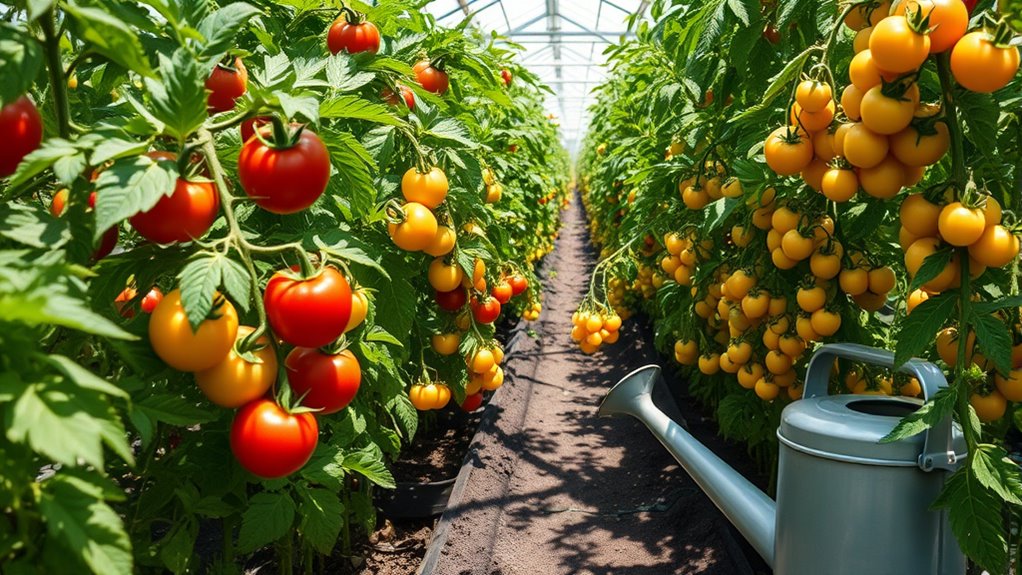
Choosing the right tomato varieties is essential for a successful greenhouse garden.
You'll want to take into account indeterminate varieties for a long harvest season, as they produce fruit continuously. If space is tight, determinate or dwarf varieties are perfect, offering compact growth without sacrificing yield. Semi-determinate options provide a balance between the two.
Think about hybrid tomatoes for their disease resistance and higher yields, or heirloom varieties if you crave unique flavors and textures.
Don't forget to select varieties with specific resistances, like powdery mildew and nematodes, to guarantee your plants stay healthy.
Preparing the Greenhouse Environment
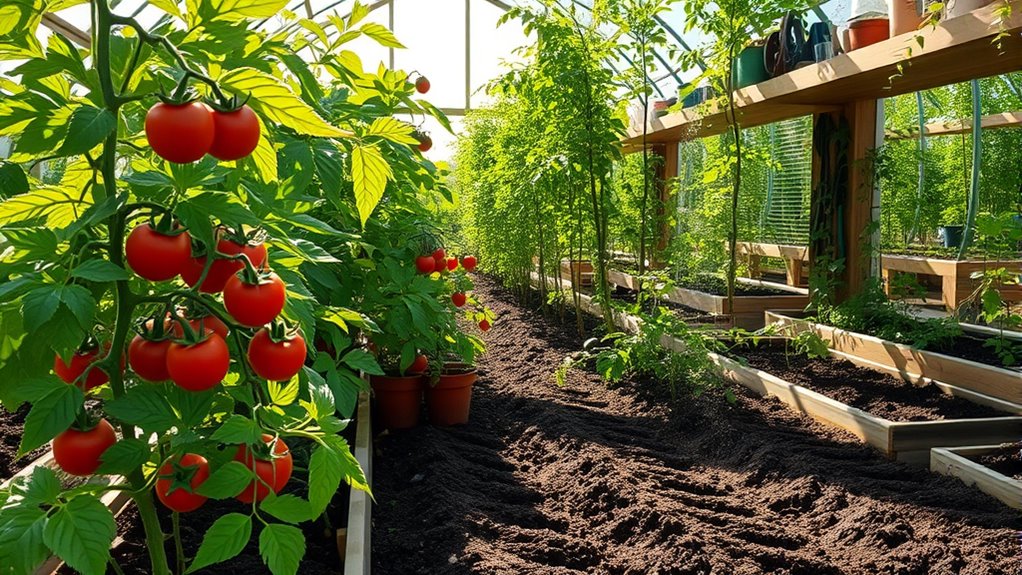
To guarantee your tomatoes thrive in the greenhouse, it's crucial to create the right environment.
Start by maintaining daytime temperatures between 70°F and 80°F (21°C to 27°C) and keeping nights above 65°F (18°C). Use ventilation windows for air circulation and install heaters in winter to guarantee consistent warmth.
For lighting, utilize natural sunlight, and supplement with high-pressure sodium lights in winter to provide 16 to 18 hours of light daily.
Manage humidity by implementing ventilation strategies and using hygrometers to monitor levels. Keep the greenhouse clean to prevent pests and diseases, and make sure your structure is intact with no leaks.
Finally, optimize plant spacing for air circulation and install supports for indeterminate varieties.
Soil and Nutrient Management

Creating the right environment in your greenhouse sets the stage for successful tomato growth, but it's the soil and nutrients that truly fuel their development.
Start with loamy soil for its excellent drainage and nutrient retention; avoid sandy and clay soils unless you amend them properly. Incorporate organic matter like compost or peat to enhance soil structure and fertility.
Loamy soil is ideal for tomatoes, offering great drainage and nutrient retention; enhance it with organic matter for optimal growth.
Regular soil testing is essential to monitor important nutrients: nitrogen for leafy growth, phosphorus for roots, and potassium for fruit quality. Use liquid fertilizers for quick nutrient access and consider slow-release options for sustained feeding.
Keep an eye on water management and temperature control to guarantee your tomatoes thrive. With careful soil and nutrient management, your tomatoes will flourish.
Planting and Transplanting
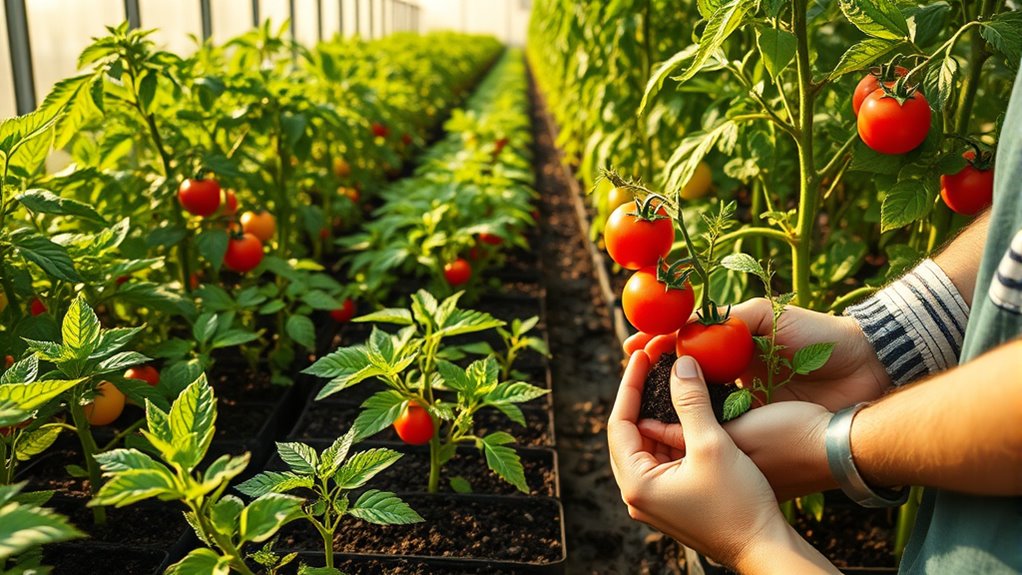
While the right soil and nutrients are essential, how and when you plant and transplant your tomato seedlings can greatly impact their success.
Start by selecting varieties bred for greenhouse conditions and sow seeds in nursery trays with a peat-based potting mix. Use heating mats to maintain a root zone temperature of 84°F for ideal germination, which typically takes 4 to 6 weeks.
Transplant seedlings when they reach 4 to 6 inches tall with their first true leaves. Prepare fresh, well-draining soil and plant them deep enough to cover 2/3 of the stem.
Confirm temperatures are above 59°F before transplanting and harden seedlings by gradually exposing them to outdoor conditions for two weeks to help them acclimate.
Pest and Disease Management
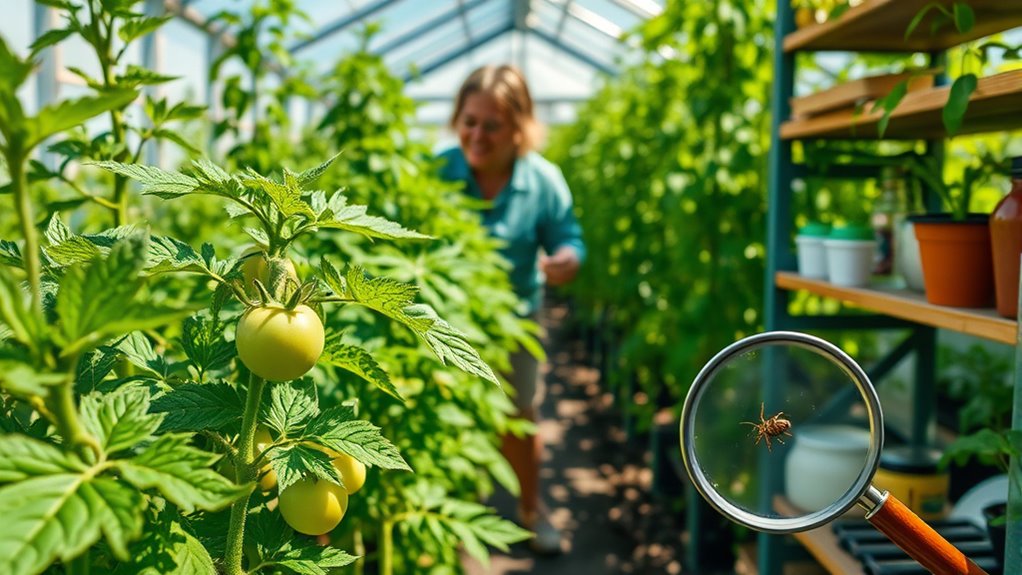
Managing pests and diseases in your greenhouse is essential to guaranteeing healthy tomato plants. Common pests like greenhouse whiteflies, aphids, and spider mites can wreak havoc on your crops. Keep an eye out for these invaders by using yellow sticky traps and regular visual inspections.
Implementing biological controls, like Encarsia for whiteflies, can help keep populations in check.
For disease management, practice crop rotation and maintain sanitation by removing debris and weeds. Ascertain good ventilation to reduce humidity, which can lead to issues like gray mold.
Use integrated pest management (IPM) strategies, combining exclusion, biological, and chemical controls when necessary. By staying vigilant and proactive, you'll cultivate thriving tomato plants in your greenhouse.
Frequently Asked Questions
How Can I Tell When My Tomatoes Are Ripe?
To tell when your tomatoes are ripe, look for a deep, consistent color, though some varieties may stay green.
Gently squeeze them; ripe tomatoes should feel tender and yield slightly to pressure.
Check how easily they come off the vine; if they twist off with minimal effort, they're ready.
A glossy sheen and a sweet fragrance also indicate ripeness.
What Are the Best Companion Plants for Tomatoes?
When you think about companion planting, it's fascinating how certain plants can boost your tomato crop.
Basil's known to enhance flavor and fend off pests, while chives deter aphids. Oregano and thyme also help repel unwanted visitors.
Adding marigolds attracts beneficial insects and keeps nematodes away. Beans enrich the soil, and cucumbers maintain moisture.
How Often Should I Water My Tomatoes?
You should check your tomato plants' soil moisture daily to determine if they need watering.
In hot weather, you'll need to water more frequently, while cooler conditions allow you to cut back.
Young plants need less water than mature ones, and smaller containers dry out faster.
Aim for about one litre per day, ensuring the soil stays moist but not soggy.
Adjust based on your plants' responses and the weather conditions.
Can I Grow Tomatoes From Store-Bought Seeds?
Yes, you can grow tomatoes from store-bought seeds, but it comes with challenges. Most store-bought tomatoes are hybrids, meaning the seeds mightn't produce plants with the same traits as the parent.
If you decide to try it, extract and clean the seeds, then ferment them to enhance germination. Remember to provide warmth and light for ideal growth.
However, consider heirloom varieties or reputable seed suppliers for more reliable results.
What Tools Do I Need for Growing Tomatoes?
Did you know that a single tomato plant can produce up to 200 tomatoes in a season?
To grow your own, you'll need essential tools like seeds or seedlings, quality soil, pots with drainage, and a reliable watering system.
Support your plants with stakes or cages, and keep pests at bay using insect nets and pest control sprays.
Monitoring temperature with thermometers and maintaining humidity guarantees ideal growing conditions for your tomatoes.
Conclusion
With the right knowledge and a little TLC, you can grow thriving tomatoes in your greenhouse. By selecting suitable varieties, creating an ideal environment, and managing soil and pests, you'll set yourself up for success. Remember, it's not just about planting a seed; it's about nurturing it to fruition. So roll up your sleeves, dig in, and enjoy the fruits of your labor—there's nothing quite like the taste of homegrown tomatoes!
